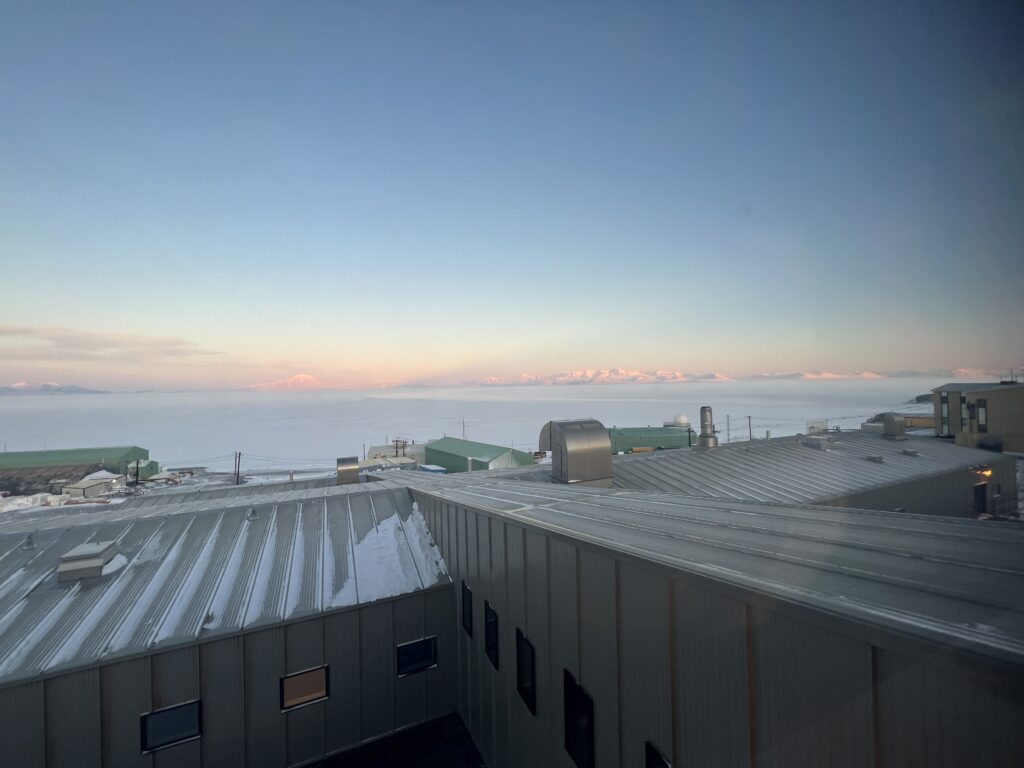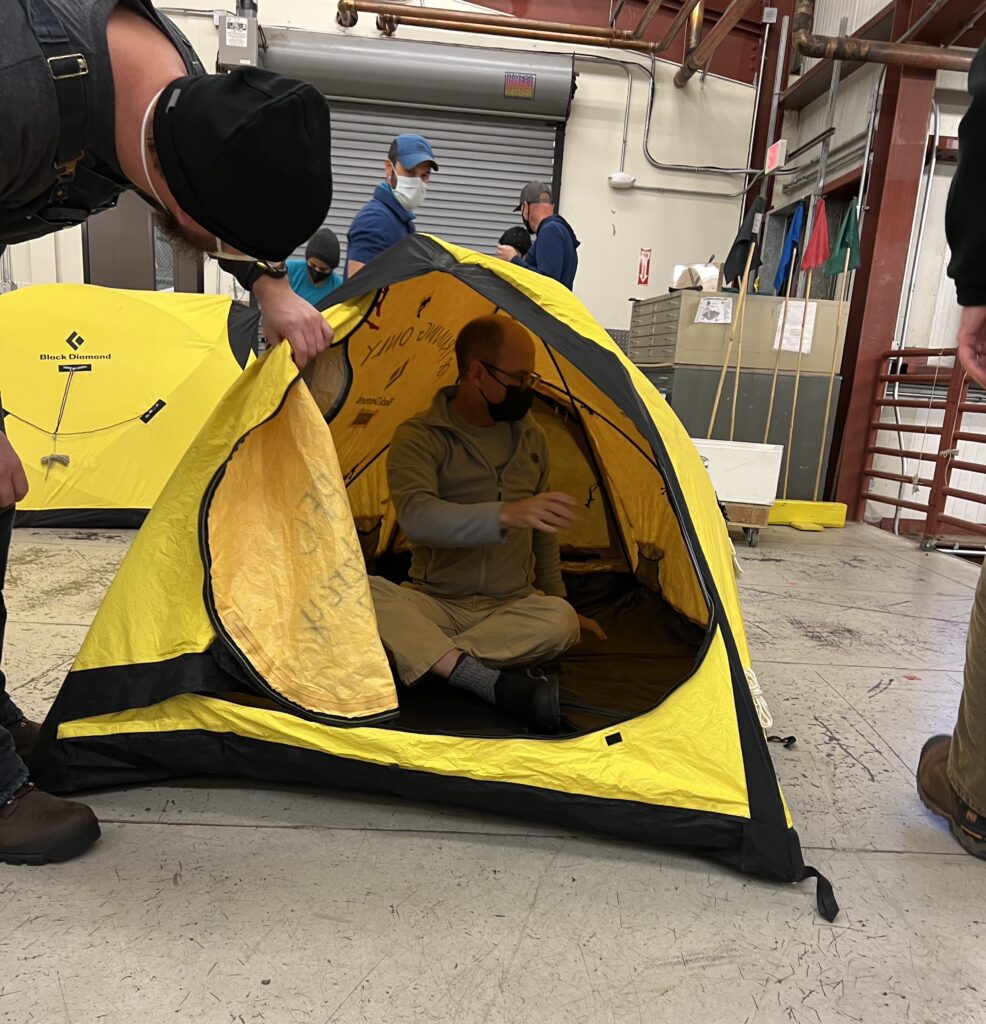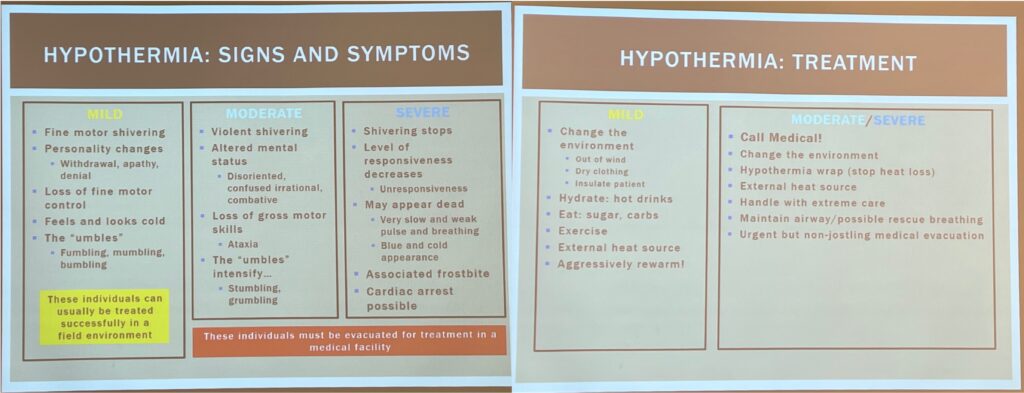31st August 2022 – our first day on the ice.

We’ve landed. We’ve settled in. And now we are ready to do science, right? WRONG!
Before we are even allowed to leave the station for a casual stroll, we must complete a long list of important training courses that will ensure we are always safe and heathy on this amazing, but harsh continent.
Training course topics include:
- Antarctic field safety
- Cold illness and injury awareness
- Light vehicle training
- Tracked vehicle training
- Helo (helicopter) safety
- General waste and recycling management
- Laboratory and chemical waste management
- Fire safety, Medical
- IT security
- Outdoor recreation safety lecture
- Sea ice safety, GPS training
- MacOps communication briefing
- Harassment awareness and prevention
- Heater use and troubleshooting
- Chainsaw safety (for cutting ice).
Today we started with the Antarctica Field Safety (AFS) course taught by the Field Support & Training (FS&T) center. [P.S. There are a LOT of acronyms used here at McMurdo!]
The purpose of this course is to provide the necessary survival training should anyone find themselves in an emergency situation while working in Antarctica.
Antarctica is one of the most beautiful and pristine places on Earth, but it also presents one of the harshest environments. In particular, the extreme cold, wind and sea ice are potential hazards that can be limb- or life-threatening. Therefore, everyone must be informed and ready to act should something untoward happen. For example, if we were working off-base, far from McMurdo Station and suddenly the weather changed for the worse, we would need to buckle down where we are and ride out the storm.
The first things we discussed in the course were all relating to Risk Management and how to identify, prevent and minimize potential risks associated with working in Antarctica. At first we brainstormed as a group to create a list of objective and subjective risks, including, but not limited to:
- extreme cold weather
- reduced visibility
- extremely strong winds
- high UV exposure (reduced ozone here)
- dehydration
- fatigue
- crevasses
- cracks in sea ice
- communication issues (broken radios etc)
We then discussed how to create a 6-step decision making model risk management tool. Again, lots of acronyms used in this part of the course including S.M.A.R.T. goals (Specific, Measurable, Achievable, Relevant, and Time-Bound) and P.A.C.E. planning (Primary, Alternate, Contingency, and Emergency).
Next we learned about survival bags. Every time a group leaves McMurdo base to work in the field, they must take with them a Survival bag. This bag contains everything needed to keep two people alive for three days in an emergency.

Contents of the survival bag:
- Sleeping bag
- Sleeping pads
- WhisperLite stove + fuel
- Snow shovel
- Food rations
- Pot and utensils
- First aid kit
- Tent
- Cord
- Spare clothing
- Ice screws
- Ice saw

After looking through the contents, we learned how to use these tools conventionally, as well as creatively. For instance, an ice saw is conventionally used to cut blocks of ice when building igloos and wall, but creatively, this long metal tool can also be used as a splint to set a fracture or sprain. Likewise, the bag itself is used to carry all the supplies, but as this is made from waterproof material, it can also be used as a windbreaker or a mini-tent for anyone entering into mild hypothermia.
Next, it was time to learn how to use the WhisperLite camping stove.

This stove can use a variety of different fuel types including white gas, kerosene, and unleaded gasoline. And it is so compact!

After this, we learned how to pitch BlackDiamond Fitzoy 3-person tents.

Although this model is a little trickier to put up compared to most other tents, its pole design and tight pitch mean that this is one of the sturdiest tents out there and suitable for weathering the harsh Antarctica storms in an emergency situation.
Okay, so the tent is up, but what do you tie the guy lines to to prevent it from blowing away in the gale? There are no trees or rocks on the sea ice… The answer: dig V-thread holes in the ice using ice screws!

You then put the guy line down one side of the v-shaped hole, and use the ice screw to catch it on the other side and pull it up. Next, use a T-hitch and secure your tent to the ice!
The last component of the Antarctic Field Safety course was Cold Illness and Injury. I have to say – although this was arguably the most important component of today’s training – I enjoyed it the least. #Squeamish. This presentation contained lots of visually disturbing images of frost-bitten fingers and toes, and something known as “degloving”. I dare you to google degloving if you are unfamiliar.
Some of the cold injuries we covered were:
- frost nip
- frostbite
- hypothermia
- chilblains
- Raynauds syndrome
- cold water immersion
Here are some of the less-gory slides from the presentation:


The take-home messages from this part of the training were:
- Your body is an engine and needs water and food as fuel. To stay warm you must eat and drink!
- Layered clothing is key to reducing heat loss in Antarctica. Start with a moisture-wicking base layer, then use fleece layers, and finally, a wind-proof outer layer is required for staying warm
- The buddy system is vital for identifying if someone is suffering from cold-induced illness or injury. If someone’s behavior changes (e.g. if a normally loud person starts to become quiet, or a normally quiet person starts to be loud and incoherent), they themselves may not be aware – so look out for one another! Likewise, if the tip of someone’s nose turns white, it is up to their buddy to let them know as they themselves may not be able to feel it!
Today’s training was 4 hours long. However, this was actually the condensed version of this course. The full-length version used to be called “Happy Camper” training, but unfortunately, they don’t teach it anymore. In the Happy Camper training, you apparently went out onto the ice, pitched your tent, cut and built an ice wall, and then spent the night sleeping on the ice in the shelter you made! We are all a bit disappointed that they don’t do this anymore as it sounded really fun! Regardless, we learned a lot in today’s course about how to survive in an emergency – and hopefully, we never need to apply any of it!



